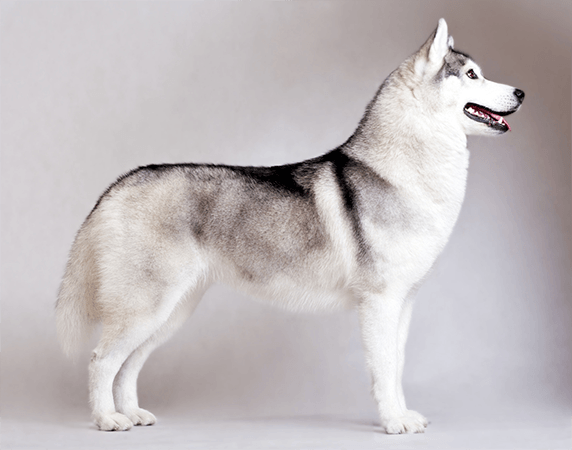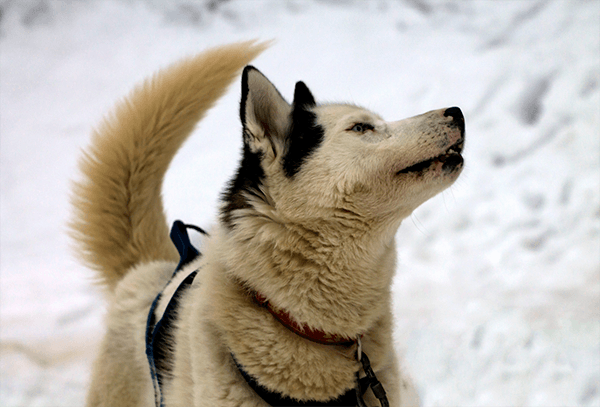Huskies are graceful, friendly dogs with mischievous personalities and long, fluffy tails. You might be wondering why your husky’s tail is curled up and whether this is a common feature in all huskies.
Why do huskies have curly tails?
Huskies do not have curly tails but rather sickle tails.
Huskies have furry tails set just below the top line. The tail is carried over the Husky’s back in a sickle curve when the dog is attentive, and they carry their tails in a low position when relaxed. However, some Huskies have trailing tails.
The curly Husky tail is a rather amusing aspect; however, it does not fall short of a long list of questions many confused owners are keen on knowing about. Continue reading for a comprehensive overview of the endearing Husky tail!
Do Huskies Have Curly Tails?

Some Huskies have tails that curl intensely, while others have sickle-shaped tails. However, it is also possible for Huskies to have a tail remaining low.
According to the American Kennel Club breed standards, huskies do not have curly tails but rather sickle tails. This often creates confusion because the word “curly” is often used to describe how curly your husky’s sickle tail is.
Dogs with true curly tails include Pugs, Shiba’s, Bulldogs, and Spitz, to name a few.
Huskies, however, tend to have a furred tail set just below the top line and are carried over the Husky’s back in a sickle curve when the dog is attentive, and they tend to carry their tails in a low position when relaxed. When the tail is carried up, it does not curl toward either side of the body; and it also doesn’t snap back flat against its back.
Faults would include a snapped or tightly curled tail, a tail set too high or too low, and a plumed tail.
The Difference Between Curly And Sickle Tails
Curly Tails: Dogs with curly tails have tails that tend to look like corkscrews. The peculiar, distinctive shape is derived from an anatomical phenomenon where the dog’s vertebrae are either wedge-shaped or have fused (medically known as “hemivertebrae”).
Curly tails are tightly wrapped upwards in an arc following the dog’s spine. Their curly tails coil up stiffly when they are attentive and when they are relaxed, their tails are carried over their backs like a plume.
Sickle Tails: Dogs, including the Husky, flaunts a sickle tail. Sickle tails are more flexible and wrap towards the dog’s back in a looser arc.
Where true curly tails stay in a coiled form, sickle tails can be held in a low and loose manner, reflecting their physical as well as emotional state.
However, it is generally acceptable to use both “curly” and “sickle” terms interchangeably since they have a similar description.
Why Do Huskies Have Sickle Tails?
Huskies are a breed of the north, belonging to the Spitz genetic family. Most breeds part of the Spitz family generally have sickle-or-curly-tails.
Researchers conclude that this feature developed due to the cold and harsh climatic conditions of the north. Their furry, sickle tails shield them against the frigid cold and are perfect for wrapping over their heads when laying down.
Do All Huskies Have Curly or Sickle Tails?

Not all Huskies have curly or sickle tails, and when they do, the curliness can vary from dogs.
Some Huskies may have curling tails, while others have long and grounded tails that do not curl at all, known as trailing tails.
The Tails Of Husky Puppies
On average, Husky puppies only start to develop a sickle tail at four to eight months old.
There is no need to worry if you have a husky puppy whose tail hasn’t curled upward yet. All dogs grow and develop at their own pace. Give your puppy more time for its to form a sickle shape.
The sickle tail shape of the Husky relies upon their lineage and degree of breeding. So, if the puppy’s parents have finely curled, sickle tails, the puppy has excellent chances of developing one too.
What Do Huskies Sickle Shaped Tails Express?
Dog’s tails speak volumes about their current moods- Huskies are no exception!
Relaxed: The dog is generally relaxed and happy when a Husky’s tail is gently curved over its back. The Husky’s tail will be soft and flexible curl.
Alert: However, if the Husky coils its tail into a tight arc over its back, note that the dog is alert, even apprehensive. The Husky’s talk will have a bristly and rigid curl to it.
Excited: An excited or thrilled Husky will wag its endearing tail in a flurry. The tail can either straighten out or maintaining the sickle shape while wagged.
Defensive: When a Husky’s tail is uncurled, low, and straight the dog is usually defensive. It’s best to stay safe and avoid the Husky when in a defensive posture.
Tired: If your Husky is feeling tired or overwhelmed, it may have a limp tail.
Does A Sickle Tail Reflect A Husky’s Breed Quality?
Many of us are led to believe that the curl of a Husky’s tail is an indicator of the breed’s purity and quality. However, this is not true; the extent of the sickle or curve does not reflect the breed purity.
Whether your Husky has a sickle tail or a trailing tail, it does not mean that it is a lower-quality Husky breed.
The American Kennel Club states that the trailing or hanging tail is entirely normal for a Husky in a relaxed state. And in regard to the tail curl, they mention that the tail should have a graceful sickle curve when alert. Lastly, the AKC says that their tail should not fall over to either left or right or snap flat against the back.
However, the AKC has particular breed standards for show dogs and prefers a graceful sickle curved tail to the trailing tail.
See more: our guide to Husky colors and markings.
Final Thoughts on Curly Tails!
It’s said that the Husky’s tail originated years ago in the north, where Huskies used their tails to keep their bodies warm.
Huskies typically have a type of curly tail known as a sickle tail with a gentle arc over their back. The extent of their curve varies vastly; and, not all Huskies have curly tails; others have long, grounded trailing tails.
To conclude, it really doesn’t matter what kind of tail your Husky is; the specifics are only for show dog standards.
